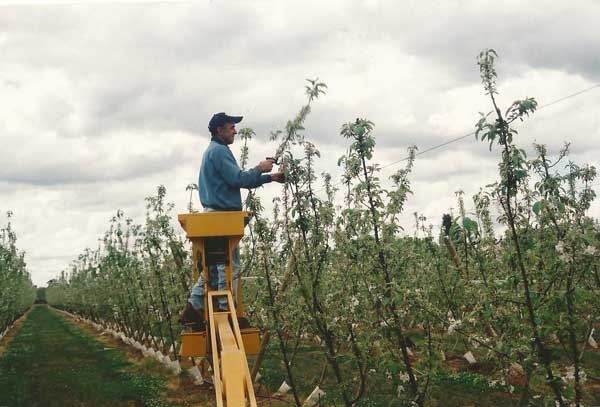With spring upon us, a new season for orchardists starts with flowers, new leaves and shoots—and much anxiety.
Newly-planted and young trees are encouraged to make as much growth as possible to fill their spaces quickly and start producing fruit.
Young trees can produce an abundance of new shoots. Some shoots are stronger than others, some have different angles than others, and some compete with the main leaders.
Removing (pruning) some of the excess growth is necessary to keep the trees open and keep the right shape and balance.
The question is: What is the best time to do this pruning?
The time of year that you prune young (and mature) trees makes a huge difference to how they respond to the pruning.
Summer
In summer, roots and top (the part that grows above the ground) grow in harmony—it’s called the allometric relationship between the roots and the top.
This simple, universal equation applies to all plants. The roots need the top, and the top needs the roots. But ultimately, the roots control the top. That’s why we like to use size-controlling rootstocks (if available).
In summer the leaves produce photosynthates, the ‘building blocks’ for growth, in the form of carbohydrates, while the roots take up water and nutrients necessary for the ‘factory’ to produce these building blocks.
Leaves and roots also produce hormones, which are chemical compounds produced in minute amounts in one part of the tree and transported to another part where they trigger a response.
In summer, you can direct (influence) growth where you want it by removing superfluous shoot growth.
The tree will redirect its growth when and where you want it to go. This is called summer pruning, and can mean delay-heading shoots, tipping or stubbing new shoots, or removing new shoots entirely.
Summer pruning maximises canopy growth and provides the type of wood that makes trees productive quickly and does not cause harmful internal shading.
Winter
Pruning young trees in winter, however, totally changes the tree’s responses from pruning in summer.
In winter, the trees rest. The amount of roots, and the number of shoots have been determined. You might not like what you see, if you pruned young trees in winter.
Putting up with excessive shoot growth is not only expensive, the tree does not like you removing it, and will fight you until the roots have re-established the relationship with the top.
The tree will often do this with more excessive shoot growth, especially in the top where many heading cuts have been made.
It really does not make horticultural sense to prune young trees in winter, and then remove much of the shoots, only to repeat the practice next winter.
If you are not yet convinced, the pictures may change your thinking and the time of pruning.
See this article and all photos in Tree Fruit Oct 2016






















